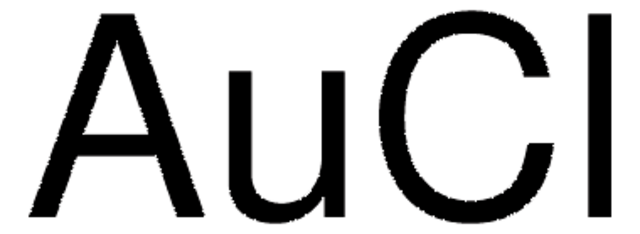254169
Gold(III) chloride hydrate
99.995% trace metals basis
Synonym(s):
Auric chloride, Chloroauric acid, Hydrogen tetrachloroaurate(III) hydrate, Tetrachloroauric(III) acid
About This Item
Recommended Products
Quality Level
Assay
99.995% trace metals basis
form
crystals and lumps
composition
Degree of hydration, ~3
reaction suitability
reagent type: catalyst
core: gold
technique(s)
ELISA: suitable
impurities
≤55.0 ppm Trace Metal Analysis
density
3.9 g/mL at 25 °C
SMILES string
O.Cl.Cl[Au](Cl)Cl
InChI
1S/Au.4ClH.H2O/h;4*1H;1H2/q+3;;;;;/p-3
InChI key
OVJUDSKPNIBLOO-UHFFFAOYSA-K
Looking for similar products? Visit Product Comparison Guide
General description
Application
Conjugate polythiophene films can be prepared by the solution-doping method using HAuCl4 as a dopant. These highly conductive polymer films can be applied in the field of vapor sensing and organic electronics.
HAuCl4 can be reduced to prepare gold nanoparticles by using different reducing agents like NaBH4, glucose, and poly (propylene imine) dendrimer.
Signal Word
Danger
Hazard Statements
Precautionary Statements
Hazard Classifications
Acute Tox. 4 Oral - Aquatic Chronic 2 - Eye Dam. 1 - Met. Corr. 1 - Skin Corr. 1B - STOT RE 2 Oral
Target Organs
Kidney
Storage Class Code
8A - Combustible, corrosive hazardous materials
WGK
WGK 3
Flash Point(F)
Not applicable
Flash Point(C)
Not applicable
Personal Protective Equipment
Certificates of Analysis (COA)
Search for Certificates of Analysis (COA) by entering the products Lot/Batch Number. Lot and Batch Numbers can be found on a product’s label following the words ‘Lot’ or ‘Batch’.
Already Own This Product?
Find documentation for the products that you have recently purchased in the Document Library.
Customers Also Viewed
Articles
Plasmonic nanoparticles have unique optical properties that can be tailored to suit a variety of applications in the biotechnology1–8 and electronics9–16 industries.
Our team of scientists has experience in all areas of research including Life Science, Material Science, Chemical Synthesis, Chromatography, Analytical and many others.
Contact Technical Service











